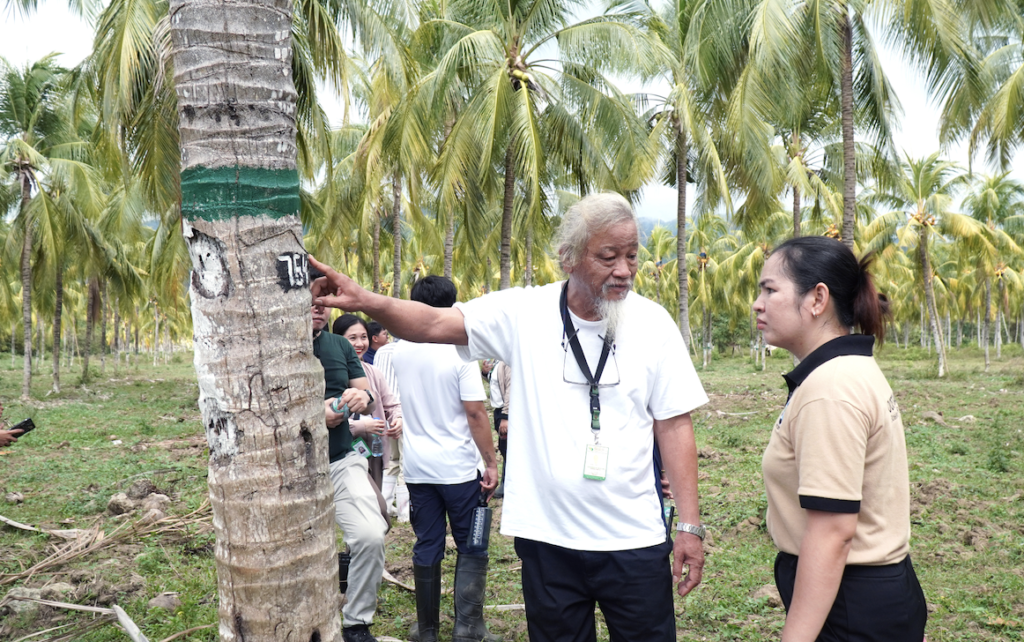A continuing project sees the potential of developing multi-parent coconut hybrids as an effective strategy to combat insect pests and diseases, enhance tolerance against drought and strong winds, and increase nut and oil yield.

The project, “Development of Multi-parent Coconut Populations using Outstanding Dwarf and Composite Varieties for Increased Yield and Tolerance against Biotic and Abiotic Stresses,” was recently reviewed by the Philippine Council for Agriculture, Aquatic and Natural Resources Research and Development of the Department of Science and Technology (DOST-PCAARRD).
Led by Mr. Gerardo B. Baylon of the Philippine Coconut Authority-Zamboanga Research Center (PCA-ZRC), the project aims to develop new coconut hybrids with multi-parents using dwarf and composite varieties. DOST-PCAARRD funds the five-year project through the Coconut Farmers and Industry Development Plan’s (CFIDP) Coconut Hybridization Program (CHP) Research.
Multi-parent populations are hybrids produced by crossing different multiple varieties. Many of these have been successfully developed globally in other crops such as oil palm, corn, cowpea, and rice to improve resistance and yield.
The project team highlighted that this initiative is a significant stride in advancing coconut breeding research in the Philippines. While the country has previously explored double or four-way cross hybrids using carefully selected tall and dwarf coconut varieties, no program has gone beyond the second generation.
The project utilizes three outstanding dwarf varieties such as Malayan Red Dwarf (MRD), Catigan Green Dwarf (CATD), and Tacunan Green Dwarf (TAGD), and two composite hybrids including BR x WB [Bago Oshiro Tall (BAOT), Renell Island Tall (RIT) x West African Tall (WAT), Baybay Tall (BAYT)] and BT × WR [BAOT, Tagnanan Tall (TAGT) × WAT, RIT]. The project team has selected 36 palms per cross for the identified dwarf varieties as mother palms and 36 sample palms of the composite varieties as pollen sources.
Using hand pollination hybridization technique, the project will cross outstanding dwarf varieties as mother palms to composite populations as pollen sources to develop six multiparent hybrids—MRD x (BR x WB), MRD x (BTxWR), CATD x (BR x WB), CATD x (BT x WB), TACD x (BR x WB), TACD x (BT x WR). Comprehensive crossing plans for the six multiparent hybrids were developed for daily monitoring.
Hand pollination hybridization techniques involve emasculation of the male flowers, bagging, and then pollinating the receptive female flowers using pollen from the identified source. The isolation bag is usually removed on the sixth day after pollination when the female flower turns brownish-black.

Aside from developing coconut hybrids, the project also aims to profile the fatty acids of eight composite varieties found at the Center to support virgin coconut oil (VCO) production in the country. Fatty acid data gathering of the said varieties for the wet season is already completed, while the preparation for data gathering during the dry season is underway.
Moreover, two plant breeders received training on coconut hybridization techniques, pollen extraction, and marker-assisted breeding. Ten project staff members were also trained in coconut field establishment and good agricultural practices.
During the project review, Science and Technology (S&T) Consultant Violeta N. Villegas recommended specifying in detail the biotic (e.g., coconut scale insects and bud rot) and abiotic (e.g., strong winds and drought) stress parameters that the project aims to evaluate in the multi-parent coconut populations.
The project review was graced by DOST Region IX Representative Thelma E. Diego and representatives from PCA’s Research and Development Branch (RDB), Region IX Offices, and CFIDP Project Management Office (PMO) via videoconferencing.
The activity was spearheaded by Crops Research Division (CRD) Director Leilani D. Pelegrina, along with CRD’s Program Monitoring and Evaluation Section Representative Alvin Quiel C. Sabanal, and Industry Strategic S&T Program (ISP) Manager for Coconut Alissa Carol M. Ibarra. Key personnel from DOST-PCAARRD’s Office of the Executive Director for Research and Development (OED-RD) and Finance and Administrative Division (FAD) Accounting Section also participated in the meeting.
Following the review, CRD validated the project’s accomplishments through a field monitoring visit at PCA-ZRC, San Ramon, Zamboanga City. (Rosemarie A. De Castro, DOST-PCAARRD S&T Media Services)



